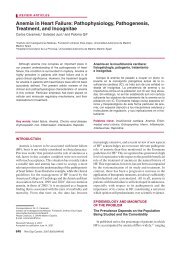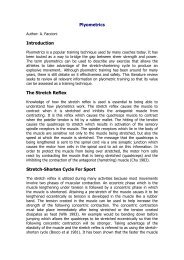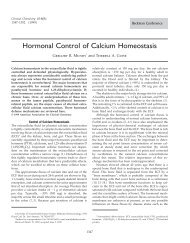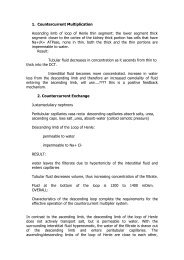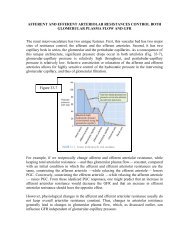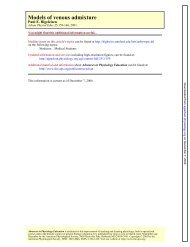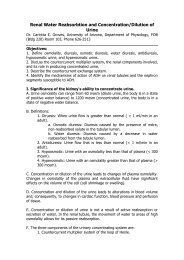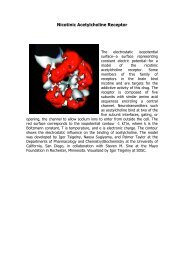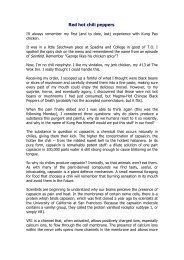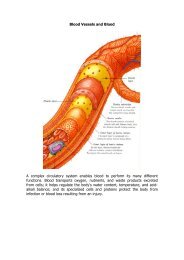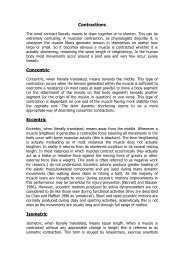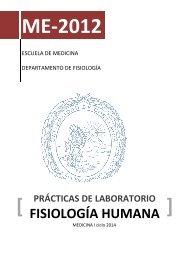578 Endocr<strong>in</strong>e Reviews, October 2003, 24(5):571–599 Thomas et al. • <strong>Gastro<strong>in</strong>test<strong>in</strong>al</strong> <strong>Hormones</strong> <strong>and</strong> <strong>Proliferation</strong>firmed a stimulatory effect <strong>of</strong> CCK on <strong>the</strong> pancreas (110–113).Taken toge<strong>the</strong>r, <strong>the</strong>se studies provide clear evidence thatCCK is a potent stimulant for pancreatic growth.Recently, <strong>the</strong> cellular mechanisms regulat<strong>in</strong>g <strong>the</strong> proliferativeeffect <strong>of</strong> CCK have been exam<strong>in</strong>ed. Similar to gastr<strong>in</strong>,CCK activates <strong>the</strong> MAPK cascade, lead<strong>in</strong>g to <strong>the</strong> activation<strong>of</strong> ERK, JNK, <strong>and</strong> p38 MAPK <strong>in</strong> <strong>the</strong> pancreas (115). In addition,<strong>the</strong>re is evidence that o<strong>the</strong>r signal<strong>in</strong>g pathways, suchas <strong>the</strong> PI3K-mTOR (mammalian target <strong>of</strong> rapamyc<strong>in</strong>)-p70 s6kpathway, are <strong>in</strong>volved <strong>in</strong> CCK-stimulated mitogenesis <strong>and</strong>cellular proliferation (115). p70 s6k is physiologically importantfor phosphorylat<strong>in</strong>g <strong>the</strong> small ribosomal subunit prote<strong>in</strong>S6, which was <strong>the</strong> first regulated phosphoprote<strong>in</strong> identified<strong>in</strong> pancreatic ac<strong>in</strong>ar cells (115), <strong>the</strong>reby facilitat<strong>in</strong>g <strong>the</strong> syn<strong>the</strong>sis<strong>of</strong> RNA. Bragado et al. (116) demonstrated <strong>the</strong> phosphorylation<strong>and</strong> activation <strong>of</strong> p70 s6k <strong>in</strong> rat pancreatic ac<strong>in</strong>i byCCK, carbachol, <strong>and</strong> BBS, but not by cAMP, phorbol ester, orcalcium ionophore. This activation was blocked by rapamyc<strong>in</strong>,which <strong>in</strong>hibits mTOR, <strong>and</strong> by wortmann<strong>in</strong> (a PI3K <strong>in</strong>hibitor).In addition, <strong>the</strong> PI3K-mTOR pathway is known toplay a role <strong>in</strong> activat<strong>in</strong>g prote<strong>in</strong> syn<strong>the</strong>sis by phosphorylat<strong>in</strong>g<strong>the</strong> b<strong>in</strong>d<strong>in</strong>g prote<strong>in</strong> eIF4E, <strong>the</strong> translation <strong>in</strong>itiation factorthat b<strong>in</strong>ds to <strong>the</strong> 7-methyl guanos<strong>in</strong>e cap at <strong>the</strong> 5 end <strong>of</strong> mosteukaryotic mRNA molecules (117). This b<strong>in</strong>d<strong>in</strong>g prote<strong>in</strong>,known as eIF4E-BP or PHAS-I, possesses multiple phosphorylatedsites <strong>and</strong>, when sufficiently phosphorylated, dissociatesfrom eIF4E, which can <strong>the</strong>n <strong>in</strong>teract with eIF4G (a scaffoldprote<strong>in</strong>) toge<strong>the</strong>r with eIF4A (a RNA helicase) to forma complex, known as eIF4F, <strong>and</strong> stimulate prote<strong>in</strong> syn<strong>the</strong>sis.CCK stimulation <strong>of</strong> rat pancreatic ac<strong>in</strong>i leads to PHAS-Iphosphorylation <strong>and</strong> <strong>in</strong>itiation <strong>of</strong> a complex formation (118).C. BBS/GRPBBS/GRP stimulates pancreatic, gastric, <strong>and</strong> <strong>in</strong>test<strong>in</strong>al secretion,<strong>and</strong> gut motility, smooth muscle contraction, <strong>and</strong>release <strong>of</strong> all gut hormones (29). In addition, BBS/GRP is apotent trophic factor for <strong>the</strong> GI tract <strong>and</strong> pancreas.1. Stomach. Lehy <strong>and</strong> colleagues (119, 120) reported that BBS,given orally or sc, stimulated <strong>the</strong> growth <strong>of</strong> gut mucosa <strong>and</strong>pancreas <strong>in</strong> neonatal rats. In this study, 7-d-old rats were<strong>in</strong>jected sc with BBS (20 g/kg) twice daily for 6 d. Gastricweight, fundic <strong>and</strong> antral mucosal height, <strong>and</strong> <strong>the</strong> density <strong>of</strong>parietal cells were <strong>in</strong>creased <strong>in</strong> BBS-treated pups comparedwith sal<strong>in</strong>e-treated controls.Demb<strong>in</strong>ski et al. (121, 122) demonstrated that BBS, adm<strong>in</strong>isteredto rats for 7 successive days, significantly <strong>in</strong>creased<strong>the</strong> weight <strong>and</strong> RNA <strong>and</strong> DNA contents <strong>of</strong> <strong>the</strong> oxyntic mucosa<strong>of</strong> <strong>the</strong> stomach <strong>and</strong> <strong>the</strong> duodenal mucosa; somatostat<strong>in</strong>attenuated <strong>the</strong> proliferative effect <strong>of</strong> BBS. Antrectomy, whichremoves <strong>the</strong> gastr<strong>in</strong>-secret<strong>in</strong>g cells, <strong>and</strong> <strong>the</strong> CCK receptor<strong>in</strong>hibitor, L-364,718, partly reduced but did not abolish <strong>the</strong>proliferative effects <strong>of</strong> BSS, suggest<strong>in</strong>g that <strong>the</strong> grow<strong>the</strong>nhanc<strong>in</strong>gmechanisms <strong>of</strong> BBS <strong>in</strong>volved gastr<strong>in</strong> <strong>and</strong> CCKstimulation. More importantly, <strong>the</strong>se studies confirmed thatBBS had direct effects on <strong>the</strong> gastroduodenal mucosa.Later, Demb<strong>in</strong>ski et al. (122) extended <strong>the</strong>ir <strong>in</strong>itial f<strong>in</strong>d<strong>in</strong>gsby assess<strong>in</strong>g <strong>the</strong> effects <strong>of</strong> <strong>the</strong> BBS/GRP receptor antagonist,RC-3095, on BBS-mediated growth. BBS (10 g/kg) adm<strong>in</strong>isteredthree times daily for 2d<strong>in</strong>fasted rats significantly<strong>in</strong>creased <strong>the</strong> rate <strong>of</strong> DNA syn<strong>the</strong>sis <strong>in</strong> <strong>the</strong> gastroduodenalmucosa <strong>and</strong> pancreas as measured by <strong>the</strong> <strong>in</strong>corporation <strong>of</strong>[ 3 H]thymid<strong>in</strong>e; this proliferative effect was abolished by RC-3095. These results provide fur<strong>the</strong>r evidence that BBS/GRPstimulates <strong>the</strong> growth <strong>of</strong> <strong>the</strong> stomach <strong>and</strong> duodenum <strong>and</strong>that <strong>the</strong>se effects are due predom<strong>in</strong>antly to a direct effect <strong>of</strong>BBS/GRP stimulation.2. Small <strong>in</strong>test<strong>in</strong>e. BBS also stimulates growth <strong>of</strong> <strong>the</strong> rema<strong>in</strong>der<strong>of</strong> <strong>the</strong> small bowel mucosa. We exam<strong>in</strong>ed <strong>the</strong> effects <strong>of</strong> BBS<strong>in</strong> <strong>the</strong> prevention <strong>of</strong> gut mucosal atrophy <strong>in</strong> Sprague-Dawleyrats given liquid ED (33). Four groups <strong>of</strong> rats were given anED <strong>and</strong> <strong>in</strong>jected with sal<strong>in</strong>e (control), pentagastr<strong>in</strong> (250 g/kg), NT (300 g/kg), or BBS (10 g/kg) sc every 8 h. A fifthgroup was fed a regular chow diet. Atrophy <strong>of</strong> <strong>the</strong> ilealmucosa was apparent on d 6 <strong>and</strong> 11, <strong>and</strong> atrophy <strong>of</strong> <strong>the</strong>jejunal mucosa was present by d 11. BBS prevented jejunalmucosal atrophy <strong>and</strong> significantly <strong>in</strong>creased ileal mucosalgrowth (mucosal weight, RNA, DNA, prote<strong>in</strong> content) comparedwith control.Chu et al. (123) determ<strong>in</strong>ed whe<strong>the</strong>r <strong>the</strong> trophic actions <strong>of</strong>BBS on <strong>the</strong> small bowel were mediated by nonlum<strong>in</strong>al orlum<strong>in</strong>al (i.e., pancreaticobiliary secretion) factors by construction<strong>of</strong> isolated small bowel loops [i.e., Thiry-Vella fistulas(TVFs)]. BBS <strong>in</strong>creased mucosal weight, DNA, <strong>and</strong> prote<strong>in</strong>content <strong>in</strong> both jejunal <strong>and</strong> ileal TVF compared withcontrol animals, suggest<strong>in</strong>g that BBS-mediated stimulation<strong>of</strong> small bowel mucosal growth is mediated by factors thatare <strong>in</strong>dependent <strong>of</strong> lum<strong>in</strong>al contents <strong>and</strong> pancreaticobiliarysecretion.In addition to its effects on gut mucosal growth, BBS exhibitsprotective effects <strong>in</strong> <strong>the</strong> gut after <strong>in</strong>jury. Us<strong>in</strong>g a lethalenterocolitis model <strong>in</strong> rats <strong>in</strong>duced by <strong>the</strong> chemo<strong>the</strong>rapeuticagent methotrexate (MTX), BBS enhanced gut mucosalgrowth <strong>and</strong> significantly <strong>in</strong>hibited mortality <strong>in</strong> rats (124). Thebeneficial effect <strong>of</strong> BBS on survival was noted when BBS wasgiven before or at <strong>the</strong> same time as MTX, which suggestedthat BBS may act through additional mechanisms o<strong>the</strong>r thangut mucosal growth alone. One possibility is that BBS mayproduce its beneficial effects through enhancement <strong>of</strong> <strong>the</strong>immune system, which is a known action <strong>of</strong> BBS (125).3. Colon. Studies assess<strong>in</strong>g <strong>the</strong> effects <strong>of</strong> BBS/GRP on <strong>the</strong>colonic mucosa are limited but, similar to <strong>the</strong> small bowel,appear to support a trophic effect <strong>of</strong> this agent <strong>in</strong> <strong>the</strong> colon.Johnson <strong>and</strong> Guthrie (126) demonstrated that BBS (20 g/kg,three times daily for 7 d) stimulated colonic mucosal growth.Puccio <strong>and</strong> Lehy (119) found that adm<strong>in</strong>istration <strong>of</strong> BBSorally <strong>in</strong> <strong>the</strong> neonatal period stimulated colonic growth. Incontrast, we have not detected a proliferative effect <strong>of</strong> BBS <strong>in</strong><strong>the</strong> colon <strong>of</strong> chow-fed rats after 7 or 14 d (127). In rats givenan ED, BBS produced a proliferative effect only <strong>in</strong> <strong>the</strong> proximalcolon. Therefore, although BBS appears to exert a trophiceffect on <strong>the</strong> colonic mucosa, <strong>the</strong> effects are less pronouncedthan <strong>in</strong> <strong>the</strong> stomach or small bowel.4. Pancreas. A number <strong>of</strong> studies have shown that BBS stimulates<strong>the</strong> growth <strong>of</strong> <strong>the</strong> pancreas (97, 119, 120, 128). Forexample, Lehy <strong>and</strong> colleagues (119, 120) demonstrated atrophic response for BBS <strong>in</strong> <strong>the</strong> pancreas as well as o<strong>the</strong>r GIDownloaded from edrv.endojournals.org by on July 16, 2007
Thomas et al. • <strong>Gastro<strong>in</strong>test<strong>in</strong>al</strong> <strong>Hormones</strong> <strong>and</strong> <strong>Proliferation</strong> Endocr<strong>in</strong>e Reviews, October 2003, 24(5):571–599 579tissues. In addition, electron morphometric analysis <strong>in</strong>dicatedthat <strong>the</strong> <strong>in</strong>crease <strong>in</strong> pancreatic weight was due to hypertrophy<strong>of</strong> <strong>the</strong> ac<strong>in</strong>ar cells. Increases <strong>in</strong> pancreatic chymotryps<strong>in</strong><strong>and</strong> tryps<strong>in</strong>ogen content were noted, with little effecton lipase or colipase <strong>and</strong> amylase levels. Similar to its effectson <strong>the</strong> pancreatic ac<strong>in</strong>i, BBS stimulates endocr<strong>in</strong>e cells <strong>of</strong> <strong>the</strong>pancreas (129).Liehr et al. (130) assessed <strong>the</strong> role <strong>of</strong> CCK <strong>in</strong> BBS-<strong>in</strong>ducedgrowth <strong>in</strong> rats. Sprague-Dawley rats received sc <strong>in</strong>jections <strong>of</strong>BBS every 8 h for 5 d, alone or <strong>in</strong> comb<strong>in</strong>ation with <strong>the</strong> CCKreceptor antagonist, L-364,718. BBS produced a dose-dependent<strong>in</strong>crease <strong>in</strong> pancreatic weight, DNA <strong>and</strong> prote<strong>in</strong> content,as well as amylase <strong>and</strong> chymotryps<strong>in</strong>ogen levels. L-364,718significantly <strong>in</strong>hibited pancreatic growth <strong>in</strong>duced by a highconcentration (5 nmol/kg) <strong>of</strong> BBS but had m<strong>in</strong>imal effects ongrowth <strong>in</strong>duced by lower dosages <strong>of</strong> BBS. These results suggestthat low doses <strong>of</strong> BBS stimulate pancreatic growth <strong>in</strong> adirect manner, <strong>in</strong>dependent <strong>of</strong> CCK, whereas high doses <strong>of</strong>BBS act <strong>in</strong> part through CCK release.More recently, Fiorucci et al. (131) found that chronic BBSadm<strong>in</strong>istration stimulated pancreatic regeneration after pancreatectomy<strong>in</strong> pigs. Fur<strong>the</strong>rmore, <strong>the</strong>se studies exam<strong>in</strong>ed<strong>the</strong> cellular processes that may be regulated by BBS. Threegroups <strong>of</strong> pigs underwent sham operation, subtotal distalpancreatectomy, or subtotal pancreatectomy comb<strong>in</strong>ed withBBS for 4 wk. After treatment, <strong>the</strong> pancreas was removed,weighed, <strong>and</strong> assayed for p42 <strong>and</strong> p44 MAPK, p46 Shc ,p52 Shc , p66 Shc , <strong>and</strong> Grb2. BBS adm<strong>in</strong>istration resulted <strong>in</strong> a100% <strong>in</strong>crease <strong>in</strong> residual pancreatic tissue when comparedwith control animals <strong>and</strong> approximately a 3-fold <strong>in</strong>crease <strong>in</strong><strong>the</strong> rate <strong>of</strong> pancreatic ac<strong>in</strong>ar cell proliferation. Also, BBSadm<strong>in</strong>istration significantly <strong>in</strong>creased p46 Shc /p52 Shc <strong>and</strong>MAPK expression <strong>and</strong>/or activity <strong>in</strong> whole pancreas extracts.These results fur<strong>the</strong>r demonstrate a proliferative effect<strong>of</strong> BBS <strong>in</strong> a large animal model <strong>and</strong> provide evidence that BBScan stimulate cell proliferation via <strong>the</strong> MAPK pathway.Upp et al. (128) demonstrated that BBS had both direct <strong>and</strong><strong>in</strong>direct actions <strong>in</strong> <strong>the</strong> pancreas. Polyam<strong>in</strong>e syn<strong>the</strong>sis, anessential part <strong>of</strong> DNA syn<strong>the</strong>sis, was assessed with BBS adm<strong>in</strong>istrationover a time course. BBS produced significantpancreatic hyperplasia (<strong>in</strong>creased pancreatic weight, prote<strong>in</strong>,<strong>and</strong> DNA content) after 14 d <strong>of</strong> treatment. CR1409, <strong>the</strong> CCKreceptor antagonist, <strong>in</strong>hibited only BBS-mediated <strong>in</strong>creases<strong>in</strong> DNA content. BBS stimulated polyam<strong>in</strong>e biosyn<strong>the</strong>sis asearly as 2 h after adm<strong>in</strong>istration; CR1409 did not <strong>in</strong>hibit this<strong>in</strong>crease <strong>in</strong> polyam<strong>in</strong>es. These results suggested that <strong>the</strong> trophicactions <strong>of</strong> BBS are both direct <strong>and</strong> <strong>in</strong>direct <strong>and</strong> that <strong>the</strong>direct effects are mediated by polyam<strong>in</strong>e syn<strong>the</strong>sis.D. NTThe physiological functions <strong>of</strong> NT <strong>in</strong> <strong>the</strong> GI tract <strong>in</strong>cludestimulation <strong>of</strong> pancreatic <strong>and</strong> biliary secretions (37) <strong>and</strong> <strong>in</strong>hibition<strong>of</strong> small bowel <strong>and</strong> gastric motility (38). In addition,NT stimulates growth <strong>of</strong> <strong>the</strong> gastric antrum, small bowel (33,34, 42), colon (132), <strong>and</strong> pancreas (40, 133).1. Stomach. Feurle et al. (40) demonstrated that sc adm<strong>in</strong>istration<strong>of</strong> high dosages <strong>of</strong> NT for 2 wk <strong>in</strong>creased prote<strong>in</strong>concentration <strong>and</strong> thickness <strong>of</strong> <strong>the</strong> gastric antrum <strong>in</strong> Wistarrats, whereas DNA content <strong>and</strong> weight were not affected. Incontrast, Hoang et al. (134) noted that NT alone had no effecton <strong>the</strong> oxyntic gl<strong>and</strong> area or <strong>the</strong> antrum, but it <strong>in</strong>hibited<strong>in</strong>creases <strong>in</strong> antral weight, DNA, <strong>and</strong> prote<strong>in</strong> <strong>in</strong>duced bysecret<strong>in</strong>. The effects <strong>of</strong> NT on antral growth are, <strong>the</strong>refore,m<strong>in</strong>imal at best <strong>and</strong> may occur with prolonged, high dosages<strong>of</strong> NT.2. Small bowel. In contrast to <strong>the</strong> stomach, <strong>the</strong> trophic effects<strong>of</strong> NT <strong>in</strong> <strong>the</strong> small bowel are more pronounced. Wood et al.(42) first noted that NT stimulated <strong>the</strong> small bowel mucosa<strong>of</strong> rats fed a normal chow diet. We have shown that adm<strong>in</strong>istration<strong>of</strong> NT prevents gut mucosal atrophy <strong>in</strong>duced byfeed<strong>in</strong>g rats an ED (Fig. 4) (Ref. 34) <strong>and</strong> stimulates mucosalgrowth <strong>in</strong> defunctionalized self-empty<strong>in</strong>g jejunoileal loopsor isolated TVFs, thus support<strong>in</strong>g a direct role for NT <strong>in</strong> <strong>the</strong>stimulation <strong>of</strong> gut mucosal growth. These f<strong>in</strong>d<strong>in</strong>gs demonstratethat NT is an important trophic hormone that canma<strong>in</strong>ta<strong>in</strong> <strong>and</strong> even augment gut mucosal structure by an<strong>in</strong>crease <strong>in</strong> overall mucosal cellularity. Consistent with ourf<strong>in</strong>d<strong>in</strong>gs, Vagianos et al. (135) reported that NT restores gutFIG. 4. NT prevents small bowel mucosal atrophy associatedwith ED. Histology <strong>of</strong> Sprague-Dawley ratsmall bowel after ED, ED <strong>and</strong> NT (<strong>in</strong>jected sc 300 g/kgthree times a day), <strong>and</strong> chow (control) for 5 d.Downloaded from edrv.endojournals.org by on July 16, 2007



